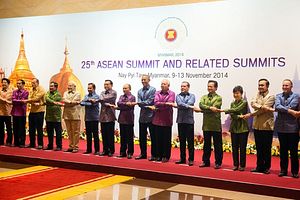On March 25, Xinhua reported that Cambodia Prime Minister Hun Sen had reiterated that the South China Sea dispute is an issue between claimant states and China, not between the Association of Southeast Asian Nations (ASEAN) and China.
“It is not the issue of the whole of ASEAN, but the issue between claimant countries and China,” he said during a graduation ceremony at the National Institute of Education. “They need to negotiate with each other.”
Hun Sen’s remarks – and Xinhua’s reporting of them – while not surprising, are deceiving. And they get to a broader point that resurfaces from time to time, including most recently in a controversy involving the ASEAN Secretary General: does ASEAN have a South China Sea position?
As with many other things in ASEAN, it’s complicated. Yes, Hun Sen is partly right in that there are officially only four ASEAN claimants in the South China Sea who actually have disputes: Brunei, Malaysia, the Philippines and Vietnam. Indonesia, as I noted in a previous piece, does not technically consider itself a claimant, even though China’s nine-dash line map overlaps with Jakarta’s exclusive economic zone (EEZ) generated from the resource-rich Natuna Islands chain.
But ASEAN as a grouping also has a position on the South China Sea, even though this is – as with other decisions in ASEAN – a lowest common denominator one which is the product of consensus between all ten countries. Rather than focus on the signing of particular documents such as the 2002 Declaration on the Conduct of Parties in the South China Sea (DOC), the best and most comprehensive recent reference point is ASEAN’s Six-Point Principles on the South China Sea. These six points principles were agreed following shuttle diplomacy by then Indonesian foreign minister Marty Natalegawa in 2012 following ASEAN’s breakdown in Phnom Penh over the South China Sea. Under the Six-Point Principles, which you can also read in full here, ASEAN foreign ministers “reiterate and reaffirm the commitment of ASEAN member states to”:
1. The full implementation of the Declaration on the Conduct of Parties in the South China Sea (2002);
2. The Guidelines for the Implementation of the Declaration on the Conduct of Parties in the South China Sea (2011);
3. The early conclusion of a Regional Code of Conduct in the South China Sea;
4. The full respect of the universally recognized principles of International Law, including the 1982 United Nations Convention on the Law of the Sea (UNCLOS);
5. The continued exercise of self-restraint and non-use of force by all parties; and
6. The peaceful resolution of disputes, in accordance with universally recognized principles of International Law, including the 1982 United Nations Convention on the Law of the Sea (UNCLOS).
Of course, even if all ASEAN countries agreed to it, the agreement is admittedly a ‘living document’ and individual states will use it in different ways to justify their own positions. That in turn makes it look like there is even less consensus in practice than is reflected in writing. Often, individual points will be cited more by some relative to others or various parties will be singled out (or not) to different degrees. The speed at which individual ASEAN states are pushing for the “early conclusion” of the COC tends to vary, and some are more upfront about highlighting how Chinese actions – or, alternatively, those of other claimant states as well – violate one or more of these six principles, including some parts of the DOC. You can also detect differences between the four claimants, interested parties (most clearly Singapore and Indonesia), and countries that are not really very interested in the issue at all and may even scuttle progress, which would include Cambodia.
In addition to this, one may also look at the statements issued after major ASEAN meetings, though of course this may differ a little depending on various factors including the situation on the ground and who the chair might be in a particular year (with Cambodia’s chairmanship in 2012 standing out as a rare, dramatic case). ASEAN may issue a separate statement on the South China Sea, may reference the issue in documents, or individual countries could emphasize the issue as well during or after meetings (see, for instance, my coverage of two recent ASEAN meetings this year here and here).
I could go on, but you get the point: while ASEAN has its detractors and is often accused of disunity on the South China Sea issue, that should not prevent us from appreciating – or at the very least acknowledging – the consensus that does exist within the grouping, however incremental, fragile or contested it might be.

































